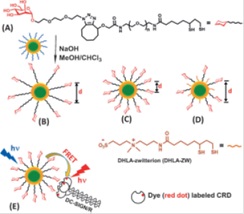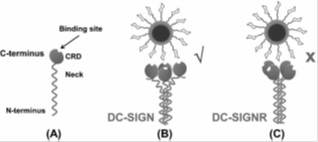On March 15, 2016, the official website of the University of Leeds released a news about quantum dot technology for the study of the mechanism of action of viruses, entitled "'Quantum dots' light the way for new HIV and Ebola treatment" ("Quantum dots" light up new HIV and Ebola treatments). A research team at the University of Leeds used quantum dot technology to simulate the process by which HIV and Ebola viruses are adsorbed into host cells for infection. The relevant research results are published in the international academic journal ANGEWANDTE CHEMIE (Guo Y, etl. Angew Chem Int Ed Engl. 2016; 55(15): 4738-42.).
Quantum dot-based FRET technology (QD FRET) has been widely used in biological diagnosis, cell monitoring and tracing. However, limited by the multi-quantity quantum dot preparation technique, QD FRET has limited research on multivalent protein-ligand interactions. The above researchers used a cap exchange method based on DHLA ligand to prepare dense and biocompatible quantum dots, which enabled QD FRET to be used for the first time to detect multivalent receptor-polysaccharide ligand interactions. This study used the dendritic cell receptor DC-SIGN and the endothelial cell receptor DC-SIGNR as a polyprotein model. These proteins recognize the human glycoma-rich surface glycoproteins on the surface of human immunodeficiency virus and Ebola virus through their clustered glycosyl recognition domains (CRDs). Simultaneous preparation of dense, multivalent, mannose-capped quantum dots, simulating the adsorption and infection process of AIDS/Ebola virus, and detecting the viral glycosylation and multivalent receptor proteins by a sensitive ratio FRET export strategy. The interaction between the two provides quantitative affinities and thermodynamic parameters. The results show that multivalent mannose-quantum dot conjugates (pseudoviruses) can be used to detect the CRD arrangement of viral receptors, and only the same CRDs can bind to quantum dots. In summary, the study developed a new viral treatment strategy that blocks the interaction of the virus with receptors on host cells, thereby preventing the spread and spread of viral infections.
 | A) The chemical structure of DHLA-PEG n -Man(dihydrolipoic acid–poly(ethylene glycol)–mannose) ligand and the mode diagram of ligand exchange method using mannose-capped quantum dots. B, C, D) Adjust the spatial spacing between the polysaccharides by the length of the PEG linker in DHLA-PEG n -Man[n = 13 (B) or 3(C)], and dilute with DHLA-zwitterion spacer (D). E) Detection of multivalent interactions between DC-SIGN/R and QD-PEG n- Man extracellular fragments by FRET. |
 | Different DC-SIGN/R-QD-Man multi-valent combination pattern diagrams. A) A DC-SIGN/R subunit structure pattern diagram. B) The vertically upward-oriented DC-SIGN CRDs combine with multiple mannose on the surface of the quantum dot to form a strong multivalent bond. C) The CRDs facing the side in the DC-SIGNR cannot simultaneously bind to multiple sugar groups on the surface of the quantum dot to form a weaker bond. |
Laser Scanning Confocal Microscope
Ningbo ProWay Optics & Electronics Co., Ltd. , https://www.proway-microtech.com